Travel to Tzefat, Emek Hefer, Havka (the survivor)
Day Eight - Monday July 10th -  - Yom Sheni
- Yom Sheni
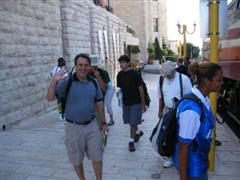 We left Jerusalem, boo hoo, it really was fabulous, and Iím going to miss it. We headed West on the same road towards Tel Aviv and the Castel towards the Palmach Museum. We left Jerusalem, boo hoo, it really was fabulous, and Iím going to miss it. We headed West on the same road towards Tel Aviv and the Castel towards the Palmach Museum.
Some things that I learned: The Palestinians were created by the Jordanians pulling
out of the West Bank and the Egyptians pulling out of Gaza. Since the
"Palestinians" were not citizens of either
country (or granted citizenship), they were left in the Palestinian area with no
home country. To this day, the UN still provides support for Palestinian refugees.
Tel Aviv has 1.8 million people. Not nearly as hilly as Jerusalem, much more modern, all over. Tel Aviv means Old and New, Tel means ďancientĒ (ruins heap), Aviv, means spring or blossom.
We visited the Palmach museum. This museum told the story of the Palmach through the eyes of a band of Israeli youth that trained together and traveled the countryside together as a military unit. The Palmach was a band of 4000 fighting youth that was integral to the fight for independence and many other battles. They were separate from the Haganim which was the main defense force. Ben Gurion wanted to unify the two, and did so during his term as Prime Minister. The Palmach lost over 1/3 of their soldiers over the time they were in effect.
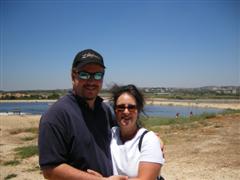 We then went to visit Emek Hefer, which is Richmondís partner in the Partner 2000 program that seeks to match a community in the USA, up with a community in Israel. This community has recently relocated many Jewish refugees caused by the displaced Jews from Gaza Strip and the West Bank. We passed Netanya on the way to Emek Hefer which is where there were several bombings. This area of Israel is only about 8 miles wide. Being so narrow is the main reason why they bombings occurred. It is hard to prevent the incursion of terrorists into such a small piece of land. We then went to visit Emek Hefer, which is Richmondís partner in the Partner 2000 program that seeks to match a community in the USA, up with a community in Israel. This community has recently relocated many Jewish refugees caused by the displaced Jews from Gaza Strip and the West Bank. We passed Netanya on the way to Emek Hefer which is where there were several bombings. This area of Israel is only about 8 miles wide. Being so narrow is the main reason why they bombings occurred. It is hard to prevent the incursion of terrorists into such a small piece of land.
 Emek Hefer sits just across the wall from Tokarem Ė an Arab town. They have developed a $10 million project that cleans the water coming in from Tokarem. The sewage cleaning system costs $1 million to operate annually. This money is taken out of money that Israel owes the Palestinian Authority for paying taxes on Arab workers in Israel. We were standing maybe 400 yards away from Tokarem in the West Bank. VERY CLOSE!!! There are currently NO relationships between the two cities as all connections were lost during the intifada. The wall extends about 4 km either side, where the fence picks up.
The wall really seems to help prevent terrorist attacks. David Endar was the one who presented the water purification system to us. Emek Hefer sits just across the wall from Tokarem Ė an Arab town. They have developed a $10 million project that cleans the water coming in from Tokarem. The sewage cleaning system costs $1 million to operate annually. This money is taken out of money that Israel owes the Palestinian Authority for paying taxes on Arab workers in Israel. We were standing maybe 400 yards away from Tokarem in the West Bank. VERY CLOSE!!! There are currently NO relationships between the two cities as all connections were lost during the intifada. The wall extends about 4 km either side, where the fence picks up.
The wall really seems to help prevent terrorist attacks. David Endar was the one who presented the water purification system to us.
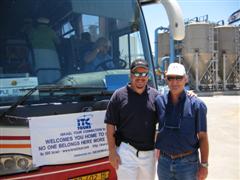 The people who resettled in Emek Hefer were from the village of Chamash. Normally it takes about 10 years for two villages to negotiate a deal to merge like this, however these two villages merged in under a year. Actually it took only 6 months! The people who resettled in Emek Hefer were from the village of Chamash. Normally it takes about 10 years for two villages to negotiate a deal to merge like this, however these two villages merged in under a year. Actually it took only 6 months!
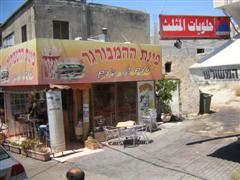 We ate at Burger King at Har Chor and Pardis Chana. It tastes just like Burger King! We ate at Burger King at Har Chor and Pardis Chana. It tastes just like Burger King!
Things I noticed: All of the toilets flush using many gallons of water, and in a country that is so concerned with water conservation. I wonder why the Americans are so stingy when it comes to water use especially when it comes to flushing!
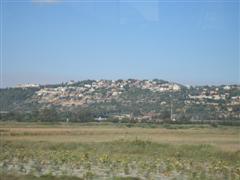 We passed Tishbi (think Eliayahu Ha-Tishbi), we detoured around Mt. Carmel. We passed Tishbi (think Eliayahu Ha-Tishbi), we detoured around Mt. Carmel.
During this ride I asked Gadi about the fact that young Yeshiva students donít have to serve in the military. This exemption was enacted by Ben Gurion, and still exists today. Back then, it only affected about 3000 students, now it is tens of thousands. The issue is not important enough to become a political issue. Most of the settlers are modern orthodox, who went to an area and claimed it as theirs.
Based on my conversations with many Israelis, I know this to be source of
friction between the orthodox and secular Jews of Israel.
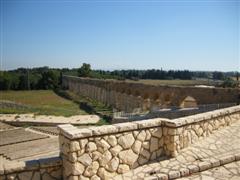 We visited Kibbutz Lohamei Haghettaot that was created by the Warsaw Ghetto survivors. This visit included a walk through the Ghetto Fighters Museum. This was fascinating museum. It told the story of the Polish Warsaw Ghetto. I always find this particular story very saddening. The movie
"The Piano" was based on this story (which We visited Kibbutz Lohamei Haghettaot that was created by the Warsaw Ghetto survivors. This visit included a walk through the Ghetto Fighters Museum. This was fascinating museum. It told the story of the Polish Warsaw Ghetto. I always find this particular story very saddening. The movie
"The Piano" was based on this story (which
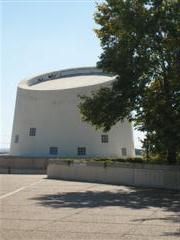 I had an emotional breakdown afterwards). We met with an actual holocaust survivor, and survivor of the Warsaw Ghetto, uprising and the underground. This was easily the most riveting moment of our trip. I had an emotional breakdown afterwards). We met with an actual holocaust survivor, and survivor of the Warsaw Ghetto, uprising and the underground. This was easily the most riveting moment of our trip.
The survivors from the Warsaw Ghetto, came to this land and created a kibbutz that remembered the past, but lived in then present and focused on the future. They have a more positive outlook on life, compared to some other survivors.
 It
really was a phenomenal opportunity to spend and hour with Havka Raban (Kibbutz Lohamei Haghettaot, Israel 25220). She
is a very determined and strong woman. Her story relayed a sense of immense strength and confidence in not only who she is, but her resolve to remember the past while focusing on the future. She has raised here family on this kibbutz. It
really was a phenomenal opportunity to spend and hour with Havka Raban (Kibbutz Lohamei Haghettaot, Israel 25220). She
is a very determined and strong woman. Her story relayed a sense of immense strength and confidence in not only who she is, but her resolve to remember the past while focusing on the future. She has raised here family on this kibbutz.
I recorded her voice on tape. I need to transcribe
her talk when I have a chance.
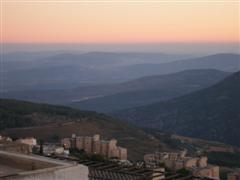 The rest of the drive to Tzefat was beautiful. Very scenic, the Sea of Galilee, was spectacular! We are staying at the Ruth Rimonim in
Tzefat (called Safed on most English maps). Larry and Francis Goldman scored BIG TIME! They have a gorgeous view of the mountain, as we do, but they have a stunning terrace where you can view the valley and mountain from three sides. The rest of the drive to Tzefat was beautiful. Very scenic, the Sea of Galilee, was spectacular! We are staying at the Ruth Rimonim in
Tzefat (called Safed on most English maps). Larry and Francis Goldman scored BIG TIME! They have a gorgeous view of the mountain, as we do, but they have a stunning terrace where you can view the valley and mountain from three sides.
We ate dinner with Bob and Anita at the hotel, buffet style. We had a nice time with them and then we retired completely exhausted from the trip to
Tzefat.
On to the next day.
[ Back ] [ Up ] [ Next ]
|